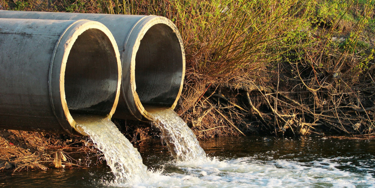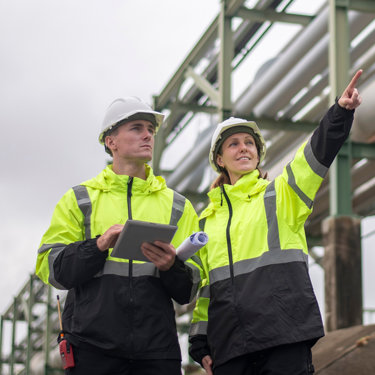9 environmental challenges for the UK wastewater industry in 2025
Published: 12 December 2024
As we approach 2025, the UK wastewater industry faces another big year of transformation. Environmental pressures, new regulatory frameworks, and technological advancements are converging, shaping the industry’s future.
From the start of the new regulatory period (AMP8) to evolving policies on combined sewer overflows (CSOs) and pollution monitoring, 2025 promises to be exciting! There are key developments expected next year, focusing on environmental challenges and the legislative shifts driving change.

1. The dawn of AMP8: A new regulatory era
April 2025 marks the beginning of AMP8 – the next Asset Management Period, running from 2025 to 2030. Building on the foundations of AMP7, which emphasised resilience and environmental outcomes, AMP8 is expected to accelerate progress toward net-zero goals and stricter pollution reduction targets.
The focus will likely shift from compliance-driven initiatives to broader environmental stewardship. Key priorities will include:
- Nature-based solutions: Expanding the adoption of sustainable drainage systems (SuDS) and wetlands to manage stormwater and reduce flooding.
- Resilient infrastructure: Replacing ageing assets to minimise system failures and pollution incidents.
- Energy efficiency: Increasing the use of renewable energy, such as anaerobic digestion and solar power, in wastewater treatment processes.
The industry will also see greater emphasis on performance-based funding, where financial incentives align with delivering measurable environmental improvements.
2. Tackling combined sewer overflows (CSOs)
The scrutiny on CSOs, which discharge untreated wastewater into water bodies during heavy rainfall (or sometimes without heavy rainfall), is intensifying. Public awareness and environmental activism, such as campaigns by groups like Surfers Against Sewage, have highlighted the ecological and health impacts of CSO pollution.
- Enhanced monitoring: The Environment Act 2021 mandates water companies to have installed monitors on all CSOs by the end of 2023. By 2025, real-time data from these systems will play a pivotal role in identifying and reducing spills.
- Tougher spill reduction targets: Companies will face stricter limits on overflow discharges, driven by the upcoming storm overflows discharge reduction plan. Significant investment in stormwater storage and treatment capacity will be essential to comply with these new standards.
- Digital innovation: Smart technologies, including AI and predictive analytics, will help utilities forecast and prevent overflow events by optimising system capacity.
3. Pollution control: Stepping up the fight
Pollution remains a pressing concern, with the Environmental Audit Committee reporting that only 14% of England’s rivers achieved “good” ecological status in 2022. In 2025, the wastewater sector will face heightened accountability for pollution incidents.
Stricter regulations
The industry will operate under enhanced oversight, with:
- Tighter discharge permits: Regulators are expected to impose stricter effluent quality standards, particularly for nutrients like phosphorus and nitrates that harm aquatic ecosystems.
- New penalties: Polluters may face higher fines as part of the government’s crackdown on environmental non-compliance.
Technological advancements
Advanced treatment technologies, such as membrane bioreactors (MBRs) and phosphate recovery systems, will become more common as utilities strive to meet tighter limits on discharge quality. Additionally, real-time monitoring systems will provide early detection of pollution events, enabling faster responses and mitigating environmental harm.
4. PFAS: Catching up with the rest of the world on emerging pollutants
PFAS (per-and poly fluoroalkyl substances) continue to pose complex challenges due to their persistence and wide-ranging environmental impacts. International collaboration and robust regulatory frameworks will be crucial in mitigating their spread and protecting ecosystems and human health from these enduring pollutants.
In wastewater, the Environment Agency (EA) may soon propose limits on PFAS discharge levels. These enhanced monitoring programs underscore efforts to gather comprehensive data on PFAS presence in groundwater, surface water, and wastewater treatment works, essential for informed regulatory decisions and effective environmental management.
The absence of specific regulatory standards for PFAS in drinking water in England and Wales highlights a critical gap in current legislation. In contrast, the United States has taken a proactive stance with the establishment of enforceable drinking water standards for six individual PFAS, accompanied by substantial financial investments for remediation. The EU similarly has acted and set limits on PFAS in drinking water. Looking ahead, the UK may follow suit with potential updates to its regulatory framework under the Environment Act 2021.
5. MCERTS legislation: A new era of monitoring
April 2025 will see the rollout of the updated MCERTS (Monitoring Certification Scheme) legislation, setting higher standards for monitoring wastewater discharges. This move reflects the increasing importance of accurate, reliable data in ensuring compliance and driving environmental improvements.
- Broader coverage: The updated scheme will apply to a wider range of discharge points, including smaller treatment works and private sewerage systems.
- Advanced technology requirements: Instruments must meet stricter accuracy and reliability standards, particularly for measuring key pollutants such as ammonia and biochemical oxygen demand.
- Data transparency: Companies will be required to share monitoring data with regulators and the public, fostering greater accountability.
This legislative shift will push the industry toward adopting cutting-edge sensors and data management systems, paving the way for smarter, more efficient operations.

6. Emerging legislation: On the horizon
Beyond MCERTS, several legislative initiatives are set to shape the wastewater industry’s environmental agenda in 2025 and beyond.
Water Framework Directive updates
While the UK has retained much of the EU Water Framework Directive (WFD) post-Brexit, 2025 may bring a UK-specific update. Expect tighter targets for waterbody restoration and a stronger emphasis on holistic catchment management approaches.
Net-zero legislation
The government’s Net Zero Strategy will likely introduce sector-specific mandates for reducing carbon emissions. For wastewater, this could mean:
- Increasing renewable energy generation at treatment plants
- Mandating the electrification of vehicle fleets used in wastewater operations
- Setting carbon-reduction targets for construction activities
New plastics regulations
Microplastics from wastewater treatment processes have drawn significant attention. 2025 may see the introduction of rules requiring utilities to implement measures like fine filtration to reduce microplastic emissions.
7. Adapting to climate change
Climate change continues to exacerbate challenges for the wastewater industry, with more frequent extreme weather events stressing ageing infrastructure. In 2025, we can expect:
- Flood resilience initiatives: Utilities will ramp up investments in infrastructure to withstand heavy rainfall and prevent flood-related pollution incidents.
- Drought management: Prolonged dry periods will spur innovations in water recycling and reuse, reducing reliance on potable water for industrial processes.
- Nature-based solutions: Expanding wetlands and vegetated areas will not only mitigate flooding but also enhance biodiversity and sequester carbon.
8. Collaboration and public engagement
The wastewater industry is increasingly recognising the importance of collaboration to tackle environmental challenges.
- Cross-sector partnerships: Utilities will work with local councils, environmental non-governmental organisations (NGOs), and academic institutions to co-develop solutions for pollution control and water management.
- Community involvement: Public engagement campaigns will educate citizens about responsible water use and the environmental impacts of wastewater mismanagement.
9. Innovations driving change
Technological advancements will play a crucial role in addressing 2025’s environmental challenges.
- Artificial intelligence and Internet of things: Predictive maintenance, powered by AI and IoT sensors, will minimise equipment failures and reduce pollution risks.
- Circular economy solutions: Technologies like nutrient recovery and biogas production will transform wastewater treatment plants into resource recovery hubs.
- Digital twins: These virtual replicas of infrastructure systems will enable utilities to simulate and optimise operations, improving efficiency and reducing environmental impacts.
Looking ahead: The road to sustainability
2025 will be a pivotal year for the UK wastewater industry as it grapples with mounting environmental challenges and stricter regulations. While these pressures will demand significant investment and innovation, they also present an opportunity to reimagine wastewater management for a more sustainable future.
The shift toward nature-based solutions, enhanced monitoring, and collaboration will not only mitigate pollution and improve water quality but also create greener, more resilient communities. By embracing these changes, the industry can position itself as a leader in the fight against climate change and biodiversity loss.
The journey won’t be without challenges, but the groundwork being laid today ensures the sector is poised to meet the demands of 2025 and beyond with ingenuity and determination. The future of wastewater management is here – and it’s greener, smarter, and more sustainable than ever.
More from our Knowledge Hub
 Insights
InsightsEarth Day 2025: Enabling a sustainable future while supporting today’s infrastructure in an evolving energy landscape
 Insights
InsightsMitigating climate change risks through planned preventive maintenance
 Insights
InsightsProtective coatings: Safeguarding infrastructure against climate change
 Insights
InsightsDelivering the Water (Special Measures) Act: Supporting compliance and innovation
Environmental compliance today, creating a sustainable tomorrow
Helping you reduce risk to the environment and your operation by managing assets compliantly while achieving commercial, ESG, and net-zero goals.
Contact our experts
